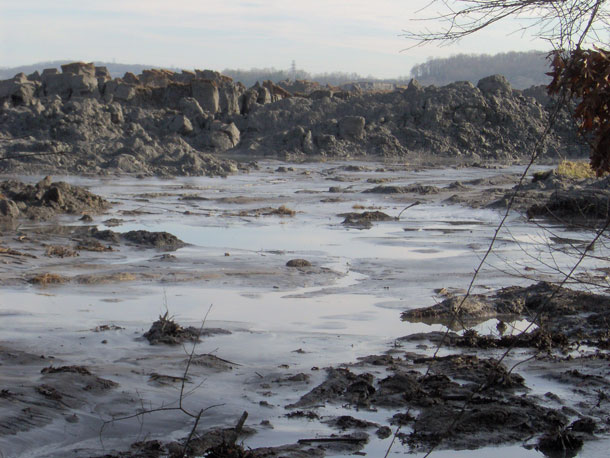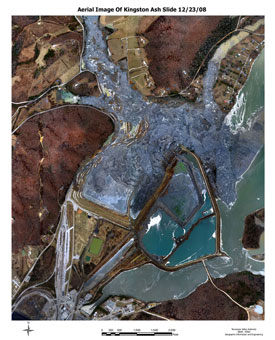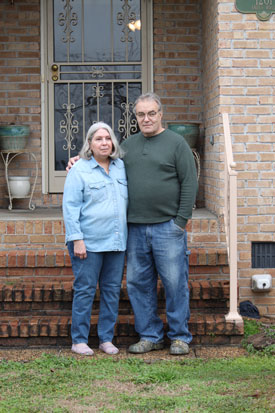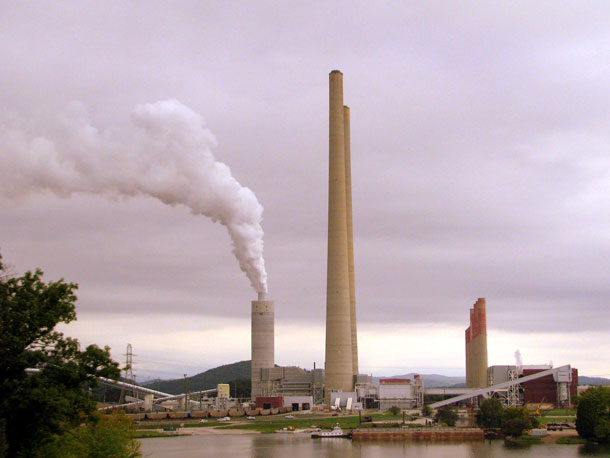Coal Ash Cleanup Allegedly Deadly for Tennessee Workers
Air Date: Week of September 13, 2019

300 acres of land were inundated by toxic coal ash slurry after the Kingston Power Plant Spill. (Photo: Wikimedia Commons, Brian Stansberry, CC)
In 2008, the wall of a pond holding a billion gallons of toxic coal ash slurry from a huge coal power plant owned by the TVA in Kingston, Tennessee suddenly collapsed. The spill contaminated 300 acres of land and required a massive cleanup project. Dozens of cleanup workers involved in have died, and hundreds more have fallen ill. Men’s Journal Senior Editor J.R. Sullivan joined Host Bobby Bascomb to talk about the fight for justice in the courts by the workers and their families.
Transcript
BASCOMB: From PRI and the Jennifer and Ted Stanley Studios at the University of Massachusetts Boston, this is Living on Earth. I’m Bobby Bascomb, in for Steve Curwood.
In 1955 the biggest coal plant in the world at that time was built near Knoxville, Tennessee and for the next 60 years its coal ash waste piled up in a huge holding pond until it burst in 2008, spilling over a billion gallons of deadly coal ash. Coal ash slurry is a toxic stew of chemicals and it spread across 300 acres of land prompting a massive cleanup project, involving 900 workers. 40 of the people who helped clean up the spill have since died, including Billy Isley. His wife Lena held her husband in her arms as he died coughing up blood. Lena is a registered nurse and she said it just didn’t look right.
ISLEY: It was thick and dark. And that's usually when something is, you know, coagulated and it just it don't look, you know, like normal blood flow. So, I knew, and every time I would try to, you know, clean his mouth out there was like particles in the blood. Little bits of black particles. And I kept thinking to myself, Oh my God I know what this is. And it was the first thing I thought of, it's just stupid coal ash you know? Because every one of these guys, that's what’s what went wrong with them is their lungs have just given out. And, they don't, you know, they can't breathe.
BASCOMB: TVA, the Tennessee Valley Authority, owns the Kingston power plant.
ISLEY: TVA killed my husband, I truly believe that TVA and Jacobs killed my husband. Because all he was out there to do was to work and provide for his family.
BASCOMB: More than 300 additional workers have fallen ill with cancer, heart failure, stroke, and lung disease. They blame their illnesses on the work they did cleaning up the coal ash spill and it has taken years to have their day in court with this corporate agency of the federal government. Jared Sullivan, Senior Editor of Men’s Journal, joins us from New York City for more. Jared, welcome to Living on Earth!
SULLIVAN: Thank you for having me, I appreciate it.
BASCOMB: So, can you briefly explain for us what happened back in 2008 that led to this huge coal sludge spill?

The coal ash byproduct also seeped into local waterways after the Kingston spill, contaminating water. (Photo: Wikimedia Commons, TVA CC)
SULLIVAN: Yeah. So, on December 22, 2008, at a TVA power plant outside of Knoxville, Tennessee, there was a six story, 80 something acre pile of coal ash. And coal ash is the byproduct of burning coal to produce electricity. Well, in the middle of the night, right before Christmas 2008, this big mountain collapsed. And it covered 300 acres, it flowed into two nearby rivers and got everywhere. If you compared the sheer volume of it, it's 100 times larger than the Exxon Valdez oil spill in it being a billion gallons in all of this coal ash that spilled. And TVA, the Tennessee Valley Authority, they own this power plant and kind of from the get go after this spill they told everyone that this this coal ash that was now covering 300 acres was totally safe. It posed no harm to the people that live near it or the people that were helping clean it up. But, jump ahead 10 years where we're at today, and now 40 people who helped clean up this coal ash are dead and 300 and something are ill.
BASCOMB: And, as you said, this is a huge spill, you know, on the scale of the Exxon Valdez, how long did the project take and how many people were involved?
SULLIVAN: So, 900 people were involved. I believe it was a almost a six year project, it was in that ballpark. So it took a long time, you know, 300 acres covered in coal ash and it was a foot deep in spots, six foot deep and others. So, it was a major undertaking.
BASCOMB: And, you write that the Tennessee Valley Authority actually said it was safe to eat. Is that right?
SULLIVAN: Yeah. So, they would have these morning safety meetings during the cleanup process. So, a TVA official would stand up in front of the workers and he would say, basically, don't worry, you could eat a pound of coal ash a day and you'd be totally fine. But, there's TVA documentation that goes back to the 80s that show that coal ash contains arsenic, lead, mercury, like a whole host of really toxic things. It's basically a Long Island Iced Tea of poison, as I put in my piece. But, yet, these officials would stand up and tell these workers regularly that this stuff was so safe. And they were given really no way to even clean themselves off. And, they're given no dust mask, no respirators and basically just are out there working in just jeans and T-shirts and hard hats.
BASCOMB: And you write that possibly part of the reason that they didn't give workers that type of safety equipment was that they didn't want to alert the people in the surrounding area, the people that live there, that there was a problem here.
SULLIVAN: Yeah, it's a great point. So, the community like had a hunch from the beginning that this stuff was hazardous, right? So, they tried to like appease their concerns and not to like further upset them or to worry them, they didn't want the workers to be wearing dust masks or respirators. And the lawyer who my story follows closely, basically found an email that says as much. Like one tells another that this is a public perception operation. Jacobs and TVA were trying to control their image, it was bad PR if the workers were out there cleaning stuff up with hazmat suits, which they should have been. And, Jacobs Engineering is the contractor that TVA hired to kind of oversee the safety and cleanup of this huge spill. But, Jacobs and TVA, they didn't want people seeing workers in that. My reporting suggests that they were trying to obscure the damages of the coal ash.
BASCOMB: And, so, when did they start getting sick? I mean, the initial spill was in 2008. How long did it take for people to start feeling symptoms?
SULLIVAN: So, when the initial spill occurred, a lot of this coal ash was really like mucky, kinda like mud, really. So, it wasn't until the summer of 2010 that a lot of the stuff began to dry. That's when the stuff started to get in the air and they really started to inhale, it was in 2010. And, that's when they really started to get sick. That's when they started to have blackouts in their trucks. That's when they started to have, a lot of them had strokes. A lot of them sort of tasted funny-- they describe it as like chewing on aluminum foil. That's how they talked about the taste of the air at that point. So, that's when a lot of them kind of all at once started to have major health issues.
BASCOMB: So, it was while they were still working on this cleanup job that they were already feeling these effects.
SULLIVAN: Oh, yeah. Oh, yeah yeah yeah.
BASCOMB: And, how did the company respond?
SULLIVAN: So, I believe was in May of 2015, a group of 25 of the workers approached a Jacobs Engineering official and asked for dust masks. And, there are some air monitors on site. And, he told them that TVA had evaluated these air monitors and that their health complaints were not linked to the coal ash and thus they were denied dust masks or respirators or any protective gear. Both companies, TVA and Jacobs, still say that the workers’ health issues are not linked to coal ash, that there's no way that this coal ash could have, could have harmed these people.

Many workers and their family members fell ill during and after the Kingston spill cleanup project, including Ansol and Janie Clark. (Photo: Courtesy of J.R. Sullivan)
BASCOMB: And, I understand that it's not just the workers themselves that are feeling these effects, but some of their families also. Can you tell me about that?
SULLIVAN: When the workers left each day there was-- they described as like a kitty litter sized container of water that they were supposed to wash their shoes off. But, that's the extent of the cleaning that they went through when they're leaving the work side each day. So, the workers would come home each day caked in mud, their boots caked in mud, their clothes caked in mud, and their kids would come up to them and give them hugs when they got home from work. A lot of these kids now have health issues because of hugging their parents when they came home from work covered in this coal ash. And a lot of workers also describe the havoc the coal ash did to their washing machines. The coal ash was so toxic that it would like literally eat apart their washing machines. One woman I spoke to had to replace her washing machine three times because this stuff just kept on eating the motors and the metal that was inside of it. So, a lot, a lot of spouses who were washing the workers’ clothes also now have issues. There's one in my story, she has had three strokes and she's only 45 years old, and she attributes the strokes to handling her husband's clothes when he'd come home from work.
BASCOMB: Gosh, I mean, if this stuff can eat apart a washing machine, imagine what it's doing to a human body.
SULLIVAN: And, the EPA does not consider coal ash a hazardous material. Really as a direct result of the Kingston spill that my story covers, the EPA began the process to implement new regulations on coal ash and how it must be stored. In 2018, as now, power companies can really just dig a big hole in the earth and dump coal ash straight into it. Without any liner, without treating this ash, just totally raw coal ash straight into the earth. There are 400 of these coal ash dump sites across the US. And, studies have shown that 90% of them leak and contaminate groundwater.
BASCOMB: You know, it just seems, I think, shocking to me, and probably most people listening, that this is how coal ash is disposed of. Surely it flies in the face of the Clean Water Act and, you know, dozens of other environmental rules that are pretty well accepted.

The Kingston coal-powered electric generating plant was the largest such power plant in the nation when it was completed in 1955. (Photo: Flickr, Brent Moore CC BY-NC 2.0)
SULLIVAN: So in 2015, the EPA began the process of regulating coal ash, and at the time the EPA was under the Obama administration; then obviously, the election happened and that really changed things as far as EPA is concerned as far as it regulating coal ash. So in 2017, the EPA began the process of rolling back the regulations that were slated to take effect in 2018. That, as I said, were a direct result of the Kingston spill.
BASCOMB: Now, I understand that there's been a lawsuit since the company is not taking responsibility for these workers. What's happening with that?

J.R. Sullivan is a senior editor with Men’s Journal. (Photo: Courtesy of J.R. Sullivan)
SULLIVAN: Yeah, so in 2012, a small group of the workers approached this lawyer in Knoxville, Tennessee, his name is Jim Scott, basically just complaining that they were not feeling well. They were coughing up blood, that they were just not feeling right. And so this lawyer, Jim Scott started to look into it. And at first, you know, I think like any lawyer, he was naturally kind of skeptical of it. But then he started digging into some past cases and do some research of coal ash and quickly realized that, my goodness, these workers are telling the truth. And, one of the workers in particular, a guy named Mike McCarthy, had secretly recorded on his cell phone a Jacobs employee telling him that if he wore a dust mask to the job site, he would be hanging himself with his own genitalia. So, seeing that secret recorded cell phone video, is what really got the lawyer Jim Scott convinced what these workers were saying were true. So, in the fall of 2018, there was a trial in which the plaintiffs had to convince the jury that the coal ash could have plausibly affected their health. And, the jury ruled in the workers’ favor, which means that now in an upcoming phase two of the trial, which will likely be in 2020, the workers will get to sue for damages relating to their specific illnesses.
BASCOMB: Jared Sullivan is senior editor of Men's Journal. Thank you so much for taking this time with me.
SULLIVAN: Thank you.
BASCOMB: We reached out to TVA and Jacobs Engineering for a response. Scott Brooks from TVA sent an email statement which said, in part, “Our major issue with this Men's Journal article is that it relies on allegations which have not been verified by facts in court. Phase two of the Jacobs litigation would determine whether anyone was actually harmed by work performed at Kingston. That hasn't been determined yet."
Links
Men’s Journal | “A Lawyer, 40 Dead Americans, and a Billion Gallons of Coal Sludge”
NATIONAL GEOGRAPHIC | "Coal’s Other Dark Side: Toxic ash that can poison water and people"
Physicians for Social Responsibility - Coal Ash: Hazardous to Human Health
Living on Earth wants to hear from you!
Living on Earth
62 Calef Highway, Suite 212
Lee, NH 03861
Telephone: 617-287-4121
E-mail: comments@loe.org
Newsletter [Click here]
Donate to Living on Earth!
Living on Earth is an independent media program and relies entirely on contributions from listeners and institutions supporting public service. Please donate now to preserve an independent environmental voice.
NewsletterLiving on Earth offers a weekly delivery of the show's rundown to your mailbox. Sign up for our newsletter today!
 Sailors For The Sea: Be the change you want to sea.
Sailors For The Sea: Be the change you want to sea.
 The Grantham Foundation for the Protection of the Environment: Committed to protecting and improving the health of the global environment.
The Grantham Foundation for the Protection of the Environment: Committed to protecting and improving the health of the global environment.
 Contribute to Living on Earth and receive, as our gift to you, an archival print of one of Mark Seth Lender's extraordinary wildlife photographs. Follow the link to see Mark's current collection of photographs.
Contribute to Living on Earth and receive, as our gift to you, an archival print of one of Mark Seth Lender's extraordinary wildlife photographs. Follow the link to see Mark's current collection of photographs.
 Buy a signed copy of Mark Seth Lender's book Smeagull the Seagull & support Living on Earth
Buy a signed copy of Mark Seth Lender's book Smeagull the Seagull & support Living on Earth

